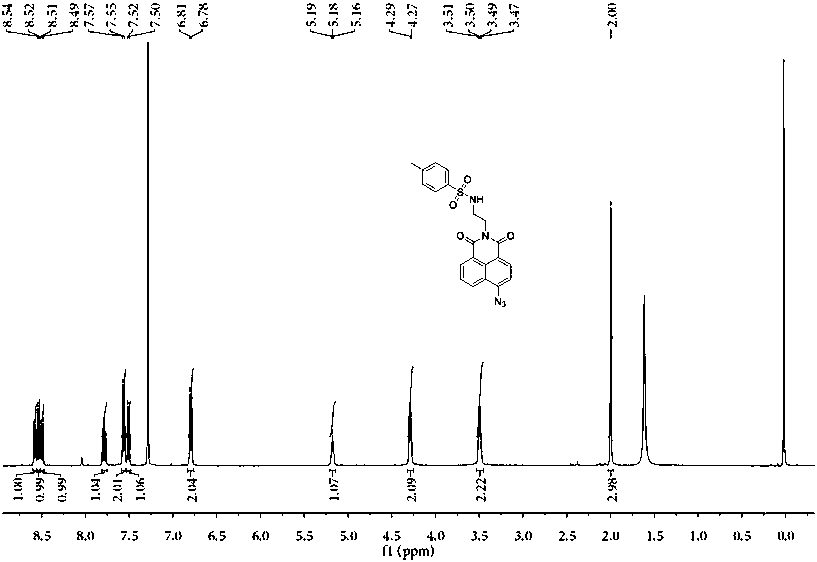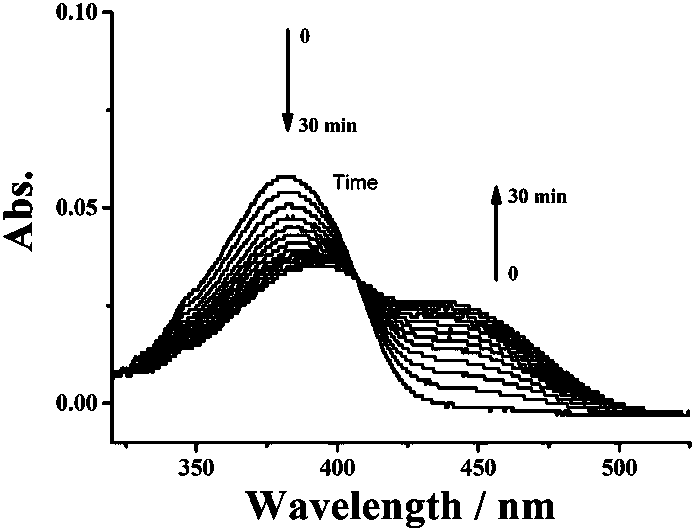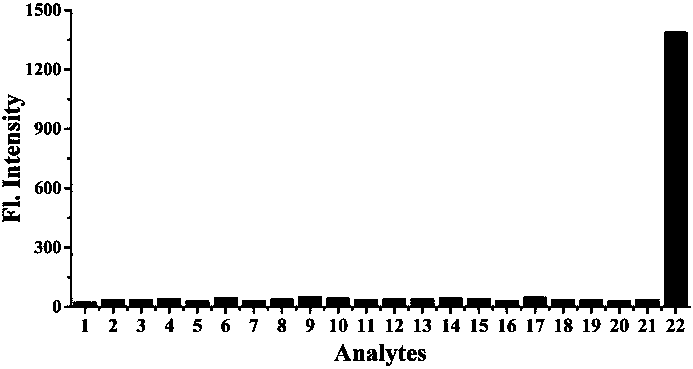Fluorescent probe for detecting hydrogen sulfide in endoplasmic reticulum
A fluorescent probe and hydrogen sulfide technology, applied in the field of fluorescent probes and organic small molecule fluorescent probes, can solve the problems of cumbersome operation, inability to monitor hydrogen sulfide transient reaction in time and space, cell and tissue sample destruction, etc.
- Summary
- Abstract
- Description
- Claims
- Application Information
AI Technical Summary
Problems solved by technology
Method used
Image
Examples
Embodiment 1
[0032] Synthesis of compound N-(2-aminoethyl)-4-methylsulfonamide (3):
[0033] ;
[0034]At 0°C, add 10 mmol ethylenediamine (1) and 20 mL dichloromethane into a 100 mL round-bottomed flask, add 30 mmol triethylamine under stirring, stir the resulting solution for 10 min, then add 5 mmol A solution of p-toluenesulfonyl chloride (2) in dichloromethane (3 mL). Then warm to room temperature and stir for 10-12 hours. Then, 20 mL of 10% sodium carbonate aqueous solution was added to the reaction to quench the reaction, and then 20 mL of dichloromethane was added to the reaction system. After the entire reaction system was washed with water three times, the organic phase was dried with anhydrous magnesium sulfate. Dichloromethane was distilled off under reduced pressure to obtain a white powder crude product, which was separated by column chromatography (petroleum ether / dichloromethane=50:1 to 10:1), and recrystallized with ethanol to obtain a white solid product N-(2-amino Et...
Embodiment 2
[0043] Hydrogen sulfide fluorescent probe Na-ER-H 2 Ultraviolet-absorption detection of the interaction between S and hydrogen sulfide
[0044] After adjusting the baseline of the UV-absorption-visible spectrophotometer with the blank solution, put 5 μM probe PBS solution containing 5% DMSO, and then add an appropriate amount of sodium sulfide aqueous solution to make the final concentration of sodium sulfide 200 μM. The UV-absorption curves of the interaction between the probe and hydrogen sulfide were tested at different times. Depend on figure 2 It can be seen that as time goes on, the absorption peak at 370 nm (the absorption peak of the probe itself) gradually decreases, while the absorption peak at 445 nm (the absorption peak of the reduced product after the probe interacts with hydrogen sulfide ) gradually increased.
Embodiment 3
[0046] Endoplasmic reticulum hydrogen sulfide fluorescent probe Na-ER-H 2 Selectivity test for S
[0047] Solution preparation: make the mother solution concentration of relevant substances to be detected: 100 mM, including: various common anions and cations, amino acids, active oxygen and nitrogen substances; make a DMSO solution with a concentration of 1 mM probe as the test mother solution.
[0048] Preparation of test solution: Measure 15 μL of probe mother solution and 135 μL of DMSO, use PBS buffer to make the volume to 3 mL, and then add an appropriate amount of analyte (so that the concentration of the analyte is: active oxygen, active nitrogen 100 μM; ion and amino acid 2.5mM), shake well and perform fluorescence detection with a fluorescence spectrometer (λ ex = 445 nm, λ em = 543 nm), and make a fluorescence intensity histogram according to the moral fluorescence curve of image 3 ),Have image 3 It was found that this fluorescent probe specifically recognizes...
PUM
 Login to View More
Login to View More Abstract
Description
Claims
Application Information
 Login to View More
Login to View More - R&D
- Intellectual Property
- Life Sciences
- Materials
- Tech Scout
- Unparalleled Data Quality
- Higher Quality Content
- 60% Fewer Hallucinations
Browse by: Latest US Patents, China's latest patents, Technical Efficacy Thesaurus, Application Domain, Technology Topic, Popular Technical Reports.
© 2025 PatSnap. All rights reserved.Legal|Privacy policy|Modern Slavery Act Transparency Statement|Sitemap|About US| Contact US: help@patsnap.com



